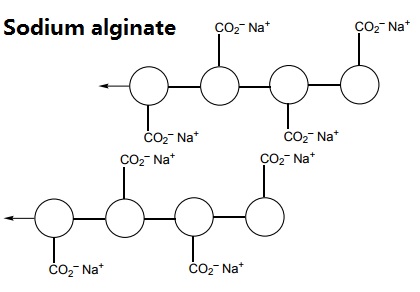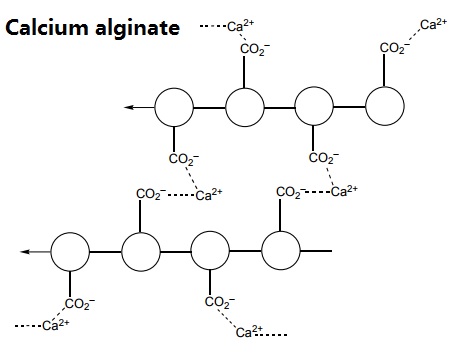| Sodium alginate Basic information |
| |
| Sodium alginate Chemical Properties |
| Melting point |
99 °C |
| density |
1.0 g/cm3(Temp: 25 °C) |
| FEMA |
2014 | ALGIN (LAMINARIA SPP. AND OTHER KELPS) |
| storage temp. |
2-8°C |
| solubility |
Slowly soluble in water forming a viscous, colloidal solution, practically insoluble in ethanol (96 per cent). |
| form |
powder |
| color |
White to Off-white |
| PH |
6.0-8.0 (10mg/mL in H2O) |
| Water Solubility |
Soluble in water. Insoluble in alcohol, chloroform and ether. |
| Sensitive |
Hygroscopic |
| Merck |
14,241 |
| Stability: |
Stable. Incompatible with strong acids, strong bases, strong oxidizing agents. |
| CAS DataBase Reference |
9005-38-3(CAS DataBase Reference) |
| EPA Substance Registry System |
Sodium alginate (9005-38-3) |
| Provider |
Language |
| Alginic acid monosodium salt |
English |
| SigmaAldrich |
English |
| ACROS |
English |
| ALFA |
English |
| |
| Sodium alginate Usage And Synthesis |
| Description |
Sodium alginate is the sodium form of alginate. Alginate is a linear, anionic polysaccharide consisting of two form of 1, 4-linked hexuronic acid residues, β-d-mannuronopyranosyl (M) and α-l- guluronopyranosyl (G) residues. It can be arranged in the form of blocks of repeating M residues (MM blocks), blocks of repeating G residues (GG blocks), and blocks of mixed M and G residues (MG blocks). Commercially available alginate currently originates from algae. Alginate has wide applications. For example, one of its most important role is being used as wound dressing materials for the treatment of acute or chronic wounds. The use of alginate crosslinking to make hydrogels for cell encapsulation is also quite valuable. The emergence of various kinds of its derivatives recently has further extended its application. |
| Chemical Properties |
Colorless or slightly yellow solid occur- ring in filamentous, granular, and powdered forms. Forms a viscous colloidal solution with water; insoluble in alcohol, ether, and chloroform. Com- bustible. |
| Chemical Properties |
Sodium alginate occurs as an odorless and tasteless, white to pale yellowish-brown colored powder. |
| History |
Sodium alginate is a natural polysaccharide product that was first described in a patent application by the British chemist Edward C C Stanford in 1881. To this day brown algae are still the main source used to extract sodium alginate from. This group includes many of the seaweeds, like kelps, found in chilly northern seas. In addition to the food industry, the gelling properties of sodium alginate have been used in medical, dental and cosmetic applications for years. |
| Uses |
- Sodium alginate can be used as a flavorless gum. It is used by the foods industry to increase viscosity and as an emulsifier. It is also used in indigestion tablets and the preparation of dental impressions.
- Sodium alginate (NaAlg) and its modified forms have been widely used as membranes in pervaporation (PV) separation of aqueous‐organic solutions because of the hydrophilic nature and versatility to modify/tune their structures to achieve the desired separation.
- Sodium alginate is a polymer which can be extracted from brown seaweed and kelps. It is one of the structural polymers that help to build the cell walls of these plants. It has some unusual properties and a wide variety of uses.
The polymer can be represented like this:

When sodium alginate is put into a solution of calcium ions, the calcium ions replace the sodium ions in the polymer. Each calcium ion can attach to two of the polymer strands. This is called cross-linking and can be represented like this:

|
| Uses |
In the manufacture of ice cream where it serves as a stabilizing colloid, insuring creamy texture and preventing the growth of ice crystals. In drilling muds; in coatings; in the flocculation of solids in water treatment; as sizing agent; thickener; emulsion stabilizer; suspending agent in soft drinks; in dental impression preparations. Pharmaceutic aid (suspending agent). |
| Uses |
alginate is used as a thickening agent in cosmetic preparations. Alginate may be used as microcapsules and is obtained from marine extracts. |
| Uses |
Sodium Alginate is a gum obtained as a sodium salt of alginic acid, which is obtained from seaweed. it is coldand hot-water soluble, producing a range of viscosities. it forms irreversible gels with cal- cium salts or acids. it functions as a thickener, binder, and gelling agent in dessert gels, puddings, sauces, toppings, and edible films. |
| Uses |
Alginate is a gum derived from alginic acid that is used to provide thickening, gelling, and binding. |
| Production Methods |
Alginic acid is extracted from brown seaweed and is neutralized with sodium bicarbonate to form sodium alginate. |
| General Description |
Alginic acid sodium is a gelling and nontoxic anionic polysaccharide. The carboxylic acid groups on the alginic acid chain, renders it insoluble in water.However, converting alginic acid to its sodium form, enables it to solubilize in water easily.
|
| Pharmaceutical Applications |
Sodium alginate is used in a variety of oral and topical pharmaceutical formulations. In tablet formulations, sodium alginate may be used as both a binder and disintegrant; it has been used as a diluent in capsule formulations. Sodium alginate has also been used in the preparation of sustained-release oral formulations since it can delay the dissolution of a drug from tablets, capsules, and aqueous suspensions. The effects of particle size, viscosity and chemical composition of sodium alginate on drug release from matrix tablets have been described.
In topical formulations, sodium alginate is widely used as a thickening and suspending agent in a variety of pastes, creams, and gels, and as a stabilizing agent for oil-in-water emulsions.
Recently, sodium alginate has been used for the aqueous microencapsulation of drugs, in contrast with the more conventional microencapsulation techniques which use organicsolvent systems. It has also been used in the formation of nanoparticles.
The adhesiveness of hydrogels prepared from sodium alginate has been investigated, and drug release from oral mucosal adhesive tablets, buccal gels, and vaginal tablets based on sodium alginate have been reported. The esophageal bioadhesion of sodium alginate suspensions may provide a barrier against gastric reflux or site-specific delivery of therapeutic agents. Other novel delivery systems containing sodium alginate include ophthalmic solutions that form a gel in situ when administered to the eye; an in situ forming gel containing paracetamol for oral administration; nasal delivery systems based on mucoadhesive microspheres; and a freeze-dried device intended for the delivery of bone-growth factors.
Hydrogel systems containing alginates have also been investigated for delivery of proteins and peptides. In addition, sodium alginate microspheres have been used in the preparation of a footmouth disease DNA vaccine, and in an oral vaccine for Helicobacter pylori; chitosan nanoparticles coated with sodium alginate may have applications in mucosal vaccine delivery systems.
Therapeutically, sodium alginate has been used in combination with an H2-receptor antagonist in the management of gastroesophageal reflux, and as a hemostatic agent in surgical dressings. Alginate dressings, used to treat exuding wounds, often contain significant amounts of sodium alginate as this improves the gelling properties. Sponges composed of sodium alginate and chitosan produce a sustained drug release and may be useful as wound dressings or as tissue engineering matrices. Lyophilized wound healing wafers composed of sodium alginate have been found to exhibit large reductions in viscosity following gamma irradiation.
Sodium alginate is also used in cosmetics and food products. |
| Safety Profile |
Poison by intravenous and intraperitoneal routes. When heated to decomposition it emits toxic fumes of Na2O |
| Safety |
Sodium alginate is widely used in cosmetics, food products, and pharmaceutical formulations, such as tablets and topical products, including wound dressings. It is generally regarded as a nontoxic and nonirritant material, although excessive oral consumption may be harmful. A study in five healthy male volunteers fed a daily intake of 175 mg/kg body-weight of sodium alginate for 7 days, followed by a daily intake of 200 mg/kg body-weight of sodium alginate for a further 16 days, showed no significant adverse effects.
TheWHOhas not specified an acceptable daily intake for alginic acid and alginate salts as the levels used in food do not represent a hazard to health.
Inhalation of alginate dust may be irritant and has been associated with industrial-related asthma in workers involved in alginate production. However, it appears that the cases of asthma were linked to exposure to seaweed dust rather than pure alginate dust.
LD50 (cat, IP): 0.25 g/kg
LD50 (mouse, IV): 0.2 g/kg
LD50 (rabbit, IV): 0.1 g/kg
LD50 (rat, IV): 1 g/kg
LD50 (rat, oral): >5 g/kg |
| storage |
Sodium alginate is a hygroscopic material, although it is stable if stored at low relative humidities and a cool temperature.
Aqueous solutions of sodium alginate are most stable at pH 4–10. Below pH 3, alginic acid is precipitated. A 1% w/v aqueous solution of sodium alginate exposed to differing temperatures had a viscosity 60–80% of its original value after storage for 2 years.) Solutions should not be stored in metal containers.
Sodium alginate solutions are susceptible on storage to microbial spoilage, which may affect solution viscosity. Solutions are ideally sterilized using ethylene oxide, although filtration using a 0.45 mm filter also has only a slight adverse effect on solution viscosity.
Heating sodium alginate solutions to temperatures above 70°C causes depolymerization with a subsequent loss of viscosity. Autoclaving of solutions can cause a decrease in viscosity, which may vary depending upon the nature of any other substances present. Gamma irradiation should not be used to sterilize sodium alginate solutions since this process severely reduces solution viscosity.
Preparations for external use may be preserved by the addition of 0.1% chlorocresol, 0.1% chloroxylenol, or parabens. If the medium is acidic, benzoic acid may also be used.
The bulk material should be stored in an airtight container in a cool, dry place. |
| Purification Methods |
Free it from heavy metal impurities by treatment with ion-exchange resins (Na+-form), or with a dilute solution of the sodium salt of EDTA. Alternatively dissolve it in 0.1M NaCl, centrifuge and fractionally precipitate it by gradual addition of EtOH or 4M NaCl. The resulting gels are centrifuged off, washed with aqueous EtOH or acetone, and dried under vacuum. [Büchner et al. J Chem Soc 3974 1961.] Sodium n-alkylsulfates. Recrystallise these salts from EtOH/Me2CO [Hashimoto & Thomas J Am Chem Soc 107 4655 1985]. |
| Incompatibilities |
Sodium alginate is incompatible with acridine derivatives, crystal violet, phenylmercuric acetate and nitrate, calcium salts, heavy metals, and ethanol in concentrations greater than 5%. Low concentrations of electrolytes cause an increase in viscosity but high electrolyte concentrations cause salting-out of sodium alginate; salting-out occurs if more than 4% of sodium chloride is present. |
| Regulatory Status |
GRAS listed. Accepted in Europe for use as a food additive. Included in the FDA Inactive Ingredients Database (oral suspensions and tablets). Included as an excipient in nonparenteral medicines (oral capsules, modified release tablets, enteric-coated tablets and lozenges) licensed in the UK. Included in the Canadian List of Acceptable Non-medicinal Ingredients. |
| References |
Pawar, Siddhesh N., and Kevin J. Edgar. Biomaterials 33.11 (2012): 3279-3305. Yang, Ji-Sheng, Ying-Jian Xie, and Wen He. Carbohydrate polymers 84.1 (2011): 33-39. |
| |
| Sodium alginate Preparation Products And Raw materials |
|
|
|
|
|
|
|
|
|
|
|
|
|
|
|

